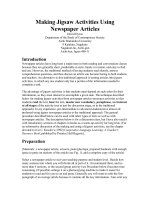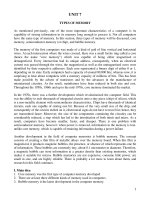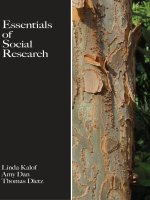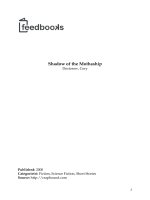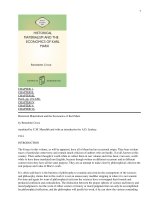TYPES OF NEWSPAPER ARTICLES pptx
Bạn đang xem bản rút gọn của tài liệu. Xem và tải ngay bản đầy đủ của tài liệu tại đây (56.58 KB, 9 trang )
Before writing a newspaper article, one must have an
understanding of the different types of articles
contained in a newspaper. Most news articles are news
stories and focus only on the facts but editorials and
columns are not considered real news stories and
usually reflect the opinion of their writer. There are
several types of news articles*:
• A local news article focuses on what's going on in
your neighbourhood. An example of a local news
story would be an article on a city council meeting.
• A national news article focuses on what's
happening in the country. An example of a national
news article would be an article on the Canadian
government passing a new bill.
• An international news article focuses on news
that's happening outside the country. A story on an
influenza outbreak in China would be considered an
international news story.
• A feature article is an article that is about "softer"
news. A feature may be a profile of a person who
does a lot of volunteer work in the community or a
movie preview. Feature articles are not considered
news stories.
• An editorial is an article that contains the writer's
opinion. Editorials are usually run all together on a
specific page of the paper and focus on current
events. Editorials are not considered news stories.
• A column is an article written by the same person
on a regular basis. A columnist (the writer of the
column) writes about subjects of interest to
him/her, current events or community happenings.
Columns are not considered news stories (-No
author).
There are certain aspects that characterize a newspaper
article. These distinguishing features need to be
considered before writing about a topic in order to have
a well structured article.
Headline and Byline
All newspaper articles should be set off with a headline.
The headline shouldn’t be a summarization of the
article; instead it should serve the purpose of getting the
reader’s attention. The byline should usually follow the
headline. This states the author’s full name. In some
cases the byline can occur and the end of the article.
Remember to not use the first person point of view in
your article (-Mass).
*The proper visual format for each type of article is
shown on the “Newspaper Articles” poster.
Lead Paragraph
The lead paragraph is the first one in a news story.
Usually, the lead is one sentence long and summarizes
the facts of the news story in order of most newsworthy
to least news-
worthy (-Knox). The lead paragraph should not tease at
the beginning or summarize at
the end, as you sometimes see on television news.
Instead, the author should lay all his/her cards out on
the table, so to speak. The lead paragraph should
include the “who, what, when, where, why, and how” of
the story (-Cigelske). Depending on the elements of
news value, the summary news lead emphasizes and
includes some or all of these components:
Who names the subject(s) of the story. The “who”, a
noun, can refer to a person, a group, a building, an
institution, a concept anything about which a story
can be written.
What is the action taking place. It is a verb that tells
what the who is doing. Reporters should always use
active voices and action verbs for the what because
they make the wording direct and lively.
When tells the time the action is happening. It is an
adverb or an adverb phrase.
Where is the place the action is happening. Again, it is
an adverb or adverb or adverb phrase.
Why, another adverb, explains the action in the lead.
How usually describes the manner in which action
occurs.
One example of a lead is: Bargainers from General
Motors and UAW Local 160 will resume talks in Warren
this morning seeking to end a day-old strike over the
transfer of jobs from unionized employees to less costly
contract workers.
The “who” in the lead above are the bargainers from
General Motors and the UAW. What are the bargainers
doing? The lead says they will resume talks.
When will the bargainers resume talks? The bargain are
meeting this morning
In our story, the “where” is Warren.
Why are the bargainers meeting? The bargainers are
meeting to discuss the transfer of jobs (-Knox).
The reader should know this information at first glance
so they are aware what the story is about and what the
emphasis is on.
The lead sets the structure for the rest of the story. If the
lead is good, the rest of the story comes together easily.
Many reporters spend half their writing time on the lead
alone. One guiding principle behind story organization
is: the structure of the story can help the reader
understand what the author is writing about. The
structure should lead the reader from idea to idea
simply and clearly. The object is to give readers
information, and wow them with convoluted style.
Transitions
With one-sentence paragraphs consisting of only one
idea block paragraphs it would be easy for a story to
appear as a series of statements without any smooth
flow from one idea to the next. Block paragraphing
makes the use of effective transitions important.
Transitions are words or phrases that link two ideas,
making the movement from one idea to the other clear
and easy. Obvious transitional phrases are: thus,
therefore, on the other hand, next, then, and so on.
Transitions in news stories are generally made by
repeating a word or phrase or using a synonym for a key
word in the preceding paragraph. Think of block graphs
as islands tied together with transition bridges of
repeated words or phrases (-Knox).
Explanation and Amplification
Following the lead paragraph comes the explanation and
amplification, which deals with illuminating details. The
author should use discretion in choosing details to
include in this part of the story. Some details may not be
as important as others and they should be presented in
order of importance from greatest to least. The author
should not feel the need to include everything he/she
knows, but include everything he/she feels is important
(-Cigelske). In addition, a direct quote should be used
after the summary statement to provide amplification or
verification, for example (-Knox).
Background Information
At a high reading level, the average reader will become
confused reading the story. Therefore, the author should
fill in the gaps with background information. When in
doubt about whether information should be included,
the author should put it in. For example, almost every
piece on the O.J. Simpson case included in the
explanation and amplification section the basic
information on what he was on trial for even though it
was basically common knowledge (-Cigelske).
Biases
Newspaper articles should be written without bias.
Personal prejudices should not find their way into the
article. The use of an op-ed or column forum is
recommended for personal opinions (-Cigelske).
Direct and Indirect Quotes
When possible, the author should use direct or indirect
quotes to enrich the article. However, quotations should
not be included just for the sake of using them: make
sure they are relevant (-Cigelske). Direct quotes can be
used in the following situations:
if a source's language is particularly colourful or
picturesque
when it is important for written information
especially official information to come from an
obviously authoritative voice
to answer the questions “why, how, who, or what?”
Remember, a direct quote repeats exactly what the
interviewee said. If a person's exact words aren’t known,
the author can paraphrase, but never change the
meaning of a person's words. When paraphrasing,
quotation marks aren’t required but the indivudal’s
name should be included after the paraphrased
sentence.
Bibliography
The article must always contain a Bibliography or
“Works Cited” list that includes at least two sources. All
sources must be documented in the correct format* (-
Sebrank).
The basic format of a newspaper article can be
condensed into a simplified explanation:
• Headline–An attention getting phrase at the top of
the article.
• Byline – By, your name.
• Lead Paragraph – Start with a strong, interesting
sentence to get the reader engaged. Include the
“who, what, when, where, why, and how” as
appropriate.
• Explanation and Amplification–This section will
include several brief paragraphs explaining the
details surrounding your photograph.
• Background Information–This section will include
several brief paragraphs explaining events leading
up to the picture, related national stories, etc. (-
Sebrank).
*Refer to the “How to Write a Bibliography” sheet
attached before the bibliography.
Bibliography
Cigelske, Azor. “How to Write a Newspaper Article.”
2004
URL:
/>paper.pdf
Knox, A. Richard. “Newspaper Writing 101.” 1997
URL:
/>Mass, L. “How to Write a Newspaper Article in Five Easy
Steps.” 2004
URL:
/>art.html
Sebrank, Patrick. “How to Write a News Article.” 1995
URL:
/>l
No author. “TYPES OF NEWSPAPER ARTICLES.” No
dates/years
URL: />
